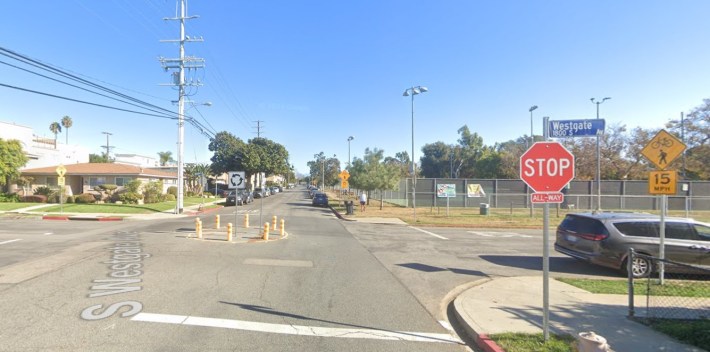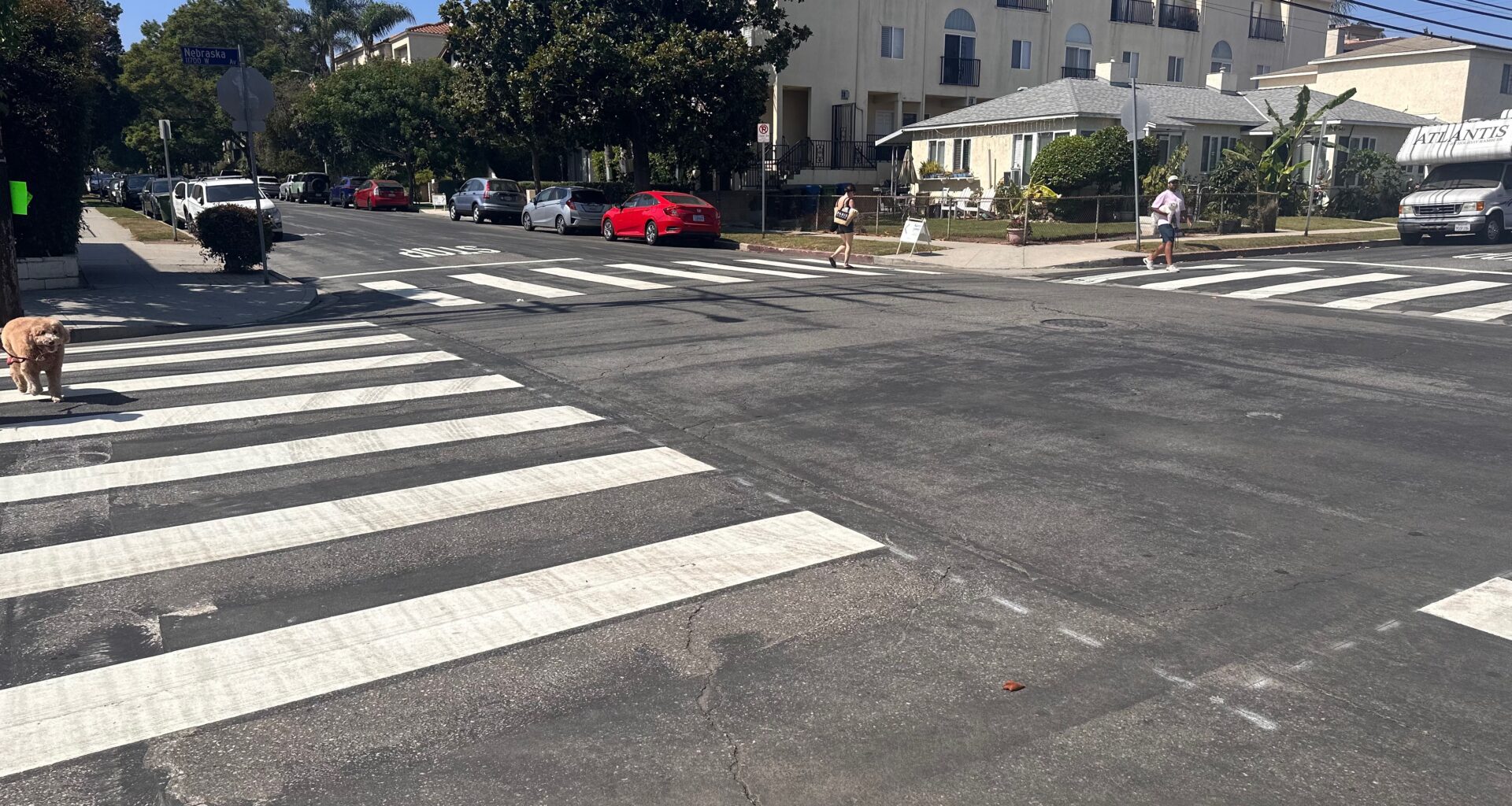The story cycle of DIY crosswalks is a familiar one to Streetsbloggers. Locals, fed up with government inaction, take to the streets themselves to paint crosswalks at a neglected and unsafe intersection. Eventually, the city takes notice and removes the crosswalks with a speed that defies logic given the amount of time it would take them to paint the crosswalks themselves. The city promises to examine the area to gauge the need for improvements…and then nothing happens.
This time, thanks in part to the ingenuity of the local advocates and intervention from the local City Council office, the story has a happier ending. After the DIY crosswalks went down and the city scrambled to remove them, one week later city vehicles returned and more-or-less restored the DIY project. (In recent years has done this erase-and-officially-reinstall dance in a few locations.)
Here’s the story of how the four intersections around Stoner Park finally got their crosswalks.
Jonathan Hale was already familiar with guerrilla tactical urbanism before he moved to Los Angeles from the Bay Area. In Oakland, the Urban Compassion Project has proven adept at trash cleanups when the city fails. Streetsblog SF readers are familiar with the Bay Area Bench Collective which, as the name suggests, puts down benches at neglected transit stops.
So when he moved to Los Angeles and saw the need for crosswalks to protect pedestrians near his own local park, he took action. Hale’s local park is Stoner Park, named after an early city leader. It’s a hundred-year-old 8-acre park, well loved and heavily used. The park has a 50-space parking lot, but most of the park perimeter has no sidewalks – just well-trod dirt paths. Some surrounding streets also lack sidewalks.
Hale trained with the L.A. Crosswalk Collective, whom he credits with “giving him the sauce” and found a few other volunteers in his neighborhood. If anyone is interested, the Crosswalk Collective has its own online guide for anyone else interested in some DIY painting projects.
At first, the crosswalk painting was aimed at just two intersections, and it took a little time.
“We started painting Saturday May 24, and then we painted every Saturday for four weeks,” Hale remembers.
“Our goal was to try and have crosswalks leading to Stoner Park at all the corners before summer camp started. At the end of the four weeks, we had eight new crosswalks, which I was pretty stoked about.”
A big part of the decision to do it themselves was they knew the city bureaucracy wouldn’t move quickly to install the crosswalks, if it ever got around to it at all.
“It would take months, if not years, to probably hear back that there wasn’t anything in the budget for it. So we figured we would just do our own thing, organize a group of neighbors,” he continues.
The city proved Hale’s point when it told the Los Angeles Times there were no active requests for crosswalks near the park, although there were a flurry of requests in 2017 and 2018.
This is a particularly baffling claim by the city. In 2020, the city of Los Angeles designated Westlake Boulevard a “Slow Street” and it received pedestrian improvements designed to allow people to exercise and be outside on the street during the pandemic while remaining social distancing. When the city used the Slow Streets as places to site more permanent infrastructure, it placed quick-build mini traffic circles at intersections and other modest mid-block traffic calming.
 City Slow Streets treatment at Stoner Park: signage and mini-traffic circle with plastic bollards. 2023 photo via Google Street View
City Slow Streets treatment at Stoner Park: signage and mini-traffic circle with plastic bollards. 2023 photo via Google Street View The Slow Streets map submitted by the Sawtelle Neighborhood Council in 2020.
The Slow Streets map submitted by the Sawtelle Neighborhood Council in 2020.
While nobody may have recently used “my311” to ask for a crosswalk, it is disappointing to see that five years after Slow Streets was launched the second slow street in the entire city still didn’t have something as basic as crosswalks.
Hale and friends hard at work.
Hale chose to release the story to the Westside Current, a favorite publication of the more conservative wing of the westside Democratic Party and Councilmember Traci Park. The Current’s first story, “No Red Tape, Just Yellow Paint: Locals Make Crosswalks Appear Overnight at Stoner Park,” painted Hale and the rest of the team as frustrated and hard-working residents. Media followups from local news and television stations took a similar tact.
The first Current article appeared on July 17. Two weeks later, city crews were busy ripping up the crosswalks. As expected, news coverage was uniformly negative against the city. When quoted, Park used the crosswalk removal to hit city bureaucracy and when pushed about the crosswalks mused that they looked fine to her.
Hale witnessed the city’s efforts to remove the crosswalks first hand, and wrote a scathing manifesto to the city. Streetsblog heard third-hand (from two different sources) that a Parks’ field deputy raised the issue with LADOT at a private meeting. Parks’ office was asked to comment and confirm for this story but hasn’t returned Streetblog’s request for comment.
But in the weeks between when the DIY crosswalk was painted and the city erasure, Park did speak to LAist and urged that the crosswalks remain. On July 29, she was quoted as saying, “ What is the worst that could possibly happen? This intersection is at least slightly more safe [with the DIY crosswalks] while we try to figure out the next steps.” See LAist for thorough coverage of whole Stoner crosswalk saga.
One week after the crosswalks were removed, the city returned to not just paint them again, but paint them at all four intersections at the corners of the park.
“Mayor Bass and Councilwoman Traci Park believe that it should be safe for people to walk, roll, bike and drive in their neighborhoods,” read a statement provided by the Mayor’s Office about the crosswalks being returned.
While Hale is grateful to the city, and especially Park, for getting the crosswalks in, the work isn’t done yet.
“I really appreciate Tracy Park’s public support in repaving the crosswalks and making improvements to Stoner Park,” he concluded. While Hale wants to see more improvements to the Stoner Park area, at least 90% of the street adjacent to the park doesn’t have sidewalks, there are also larger lessons for the city.
In the aftermath, the story of the Stoner Park crosswalks has brought back into focus the broken nature of Los Angeles’ process for new pedestrian facilities. Last weekend the Los Angeles Times published an op/ed by Thomas Irwin entitled, “It’s No Wonder Angelenos Are Painting Crosswalks Themselves,” highlighting, again, that it takes upwards of a decade once a project is proposed for it to come to fruition (if ever). The op/ed echoed issues highlighted in earlier L.A. Times news coverage of DIY crosswalks at Stoner and in Ktown (see also SBLA coverage of the Ktown facility).
City department heads recently rejected requiring new crosswalk installations in the city’s Measure HLA compliance. Advocates had urged the city to routinely install crosswalks in the city’s approved pedestrian enhancement districts. The city instead opted to treating its pedestrian districts the same as all other crosswalk-insufficient areas.
This broken process results in another statistic making the rounds on social media: the city spends hundreds of millions of dollars on lawsuits caused by unsafe sidewalks ($289 million in 2024 according to the Los Angeles Times) then it does on actually improving them.
So, if you want to get a crosswalk installed your neighborhood, the city’s fast-track process seems to be: get your neighbors to paint it unofficially (with the help of the L.A. Crosswalks Collective), then the city will scrape it away and install it officially. It’s a lot of work – and out of reach for many under-resourced communities – but it seems to be the only way to get basic pedestrian safety facilities installed these days.
